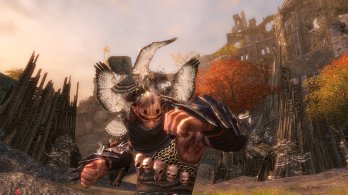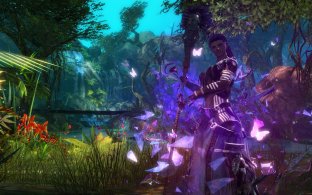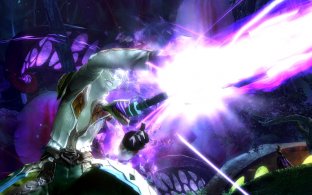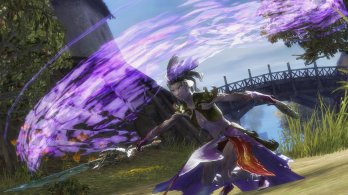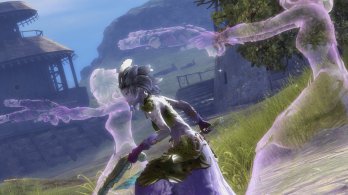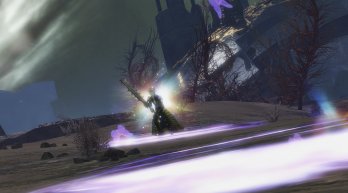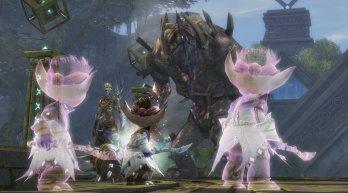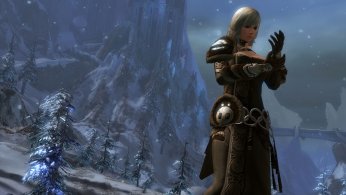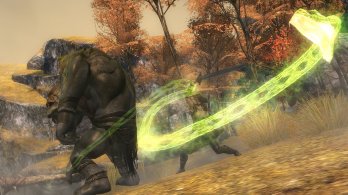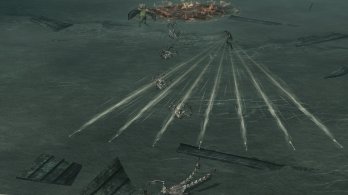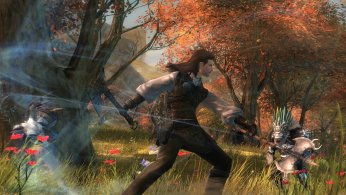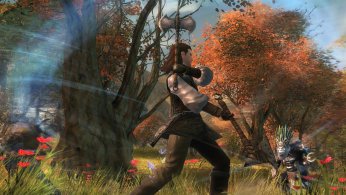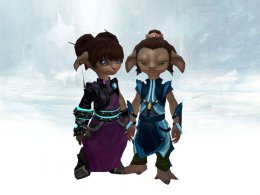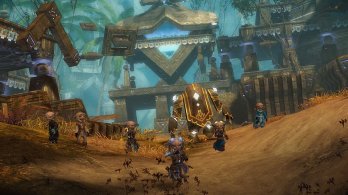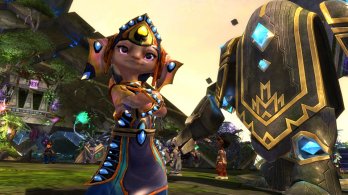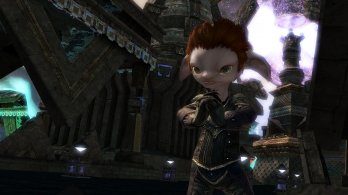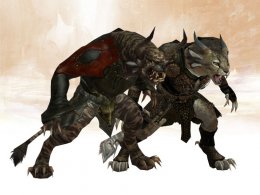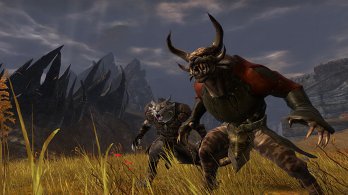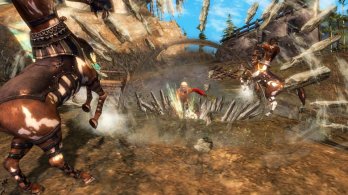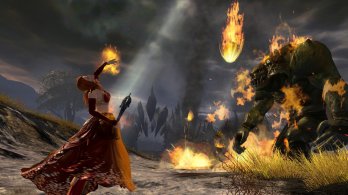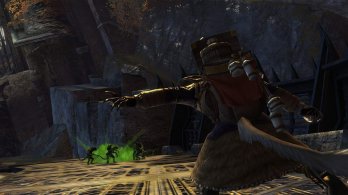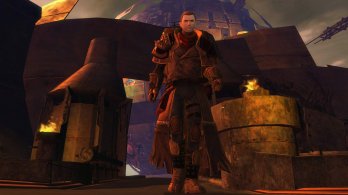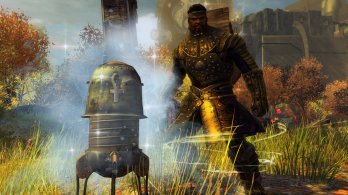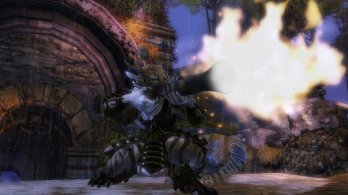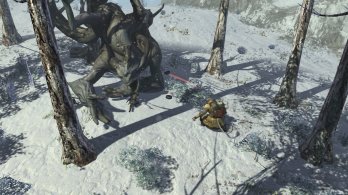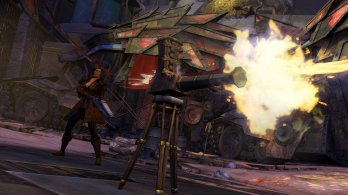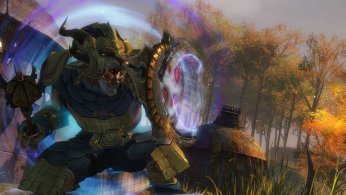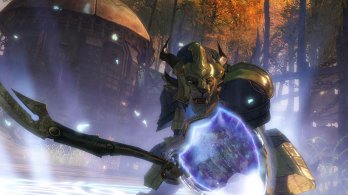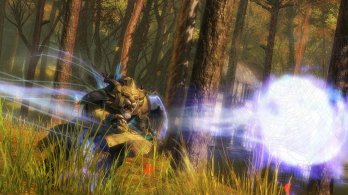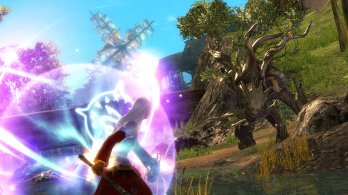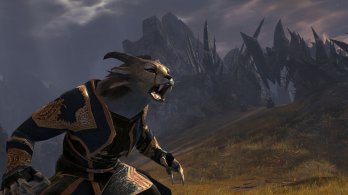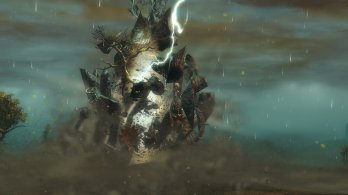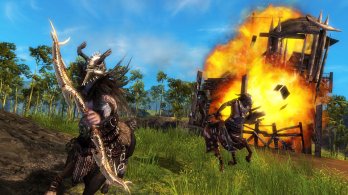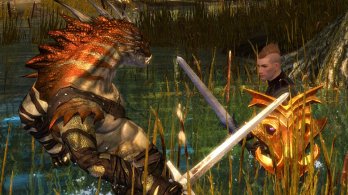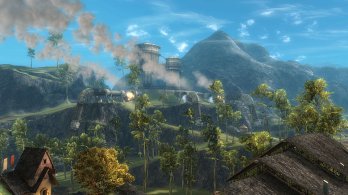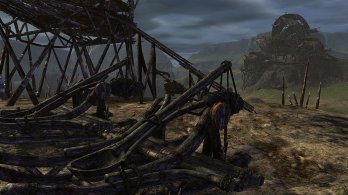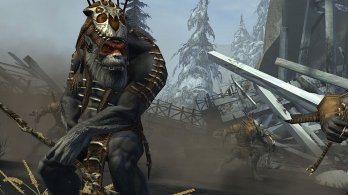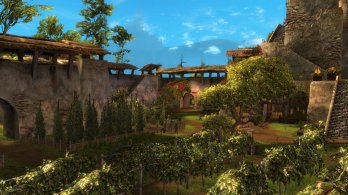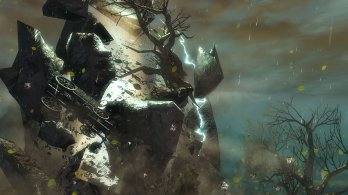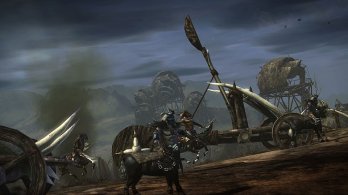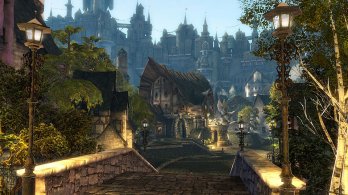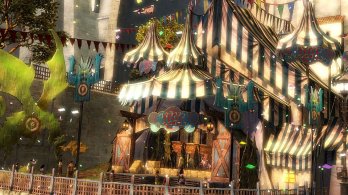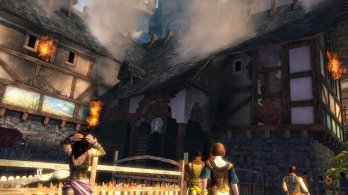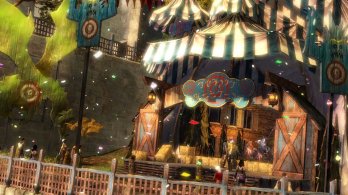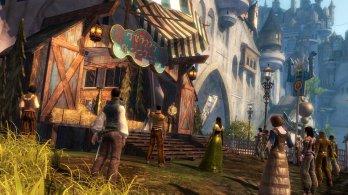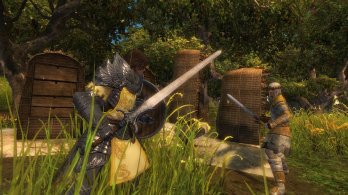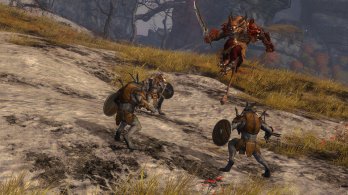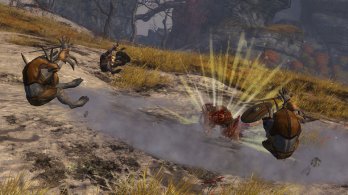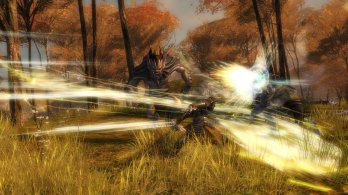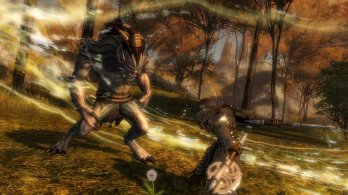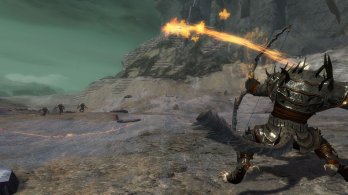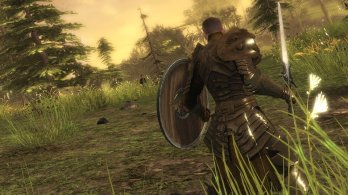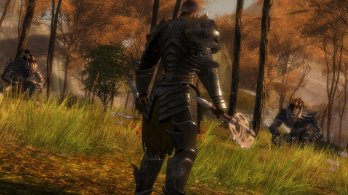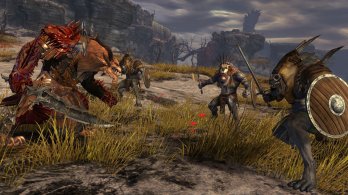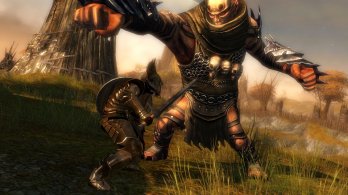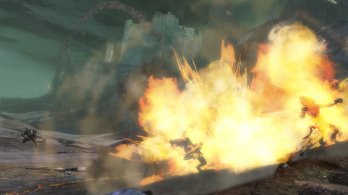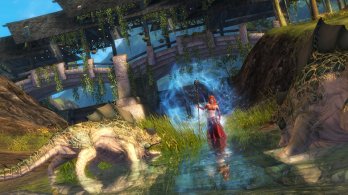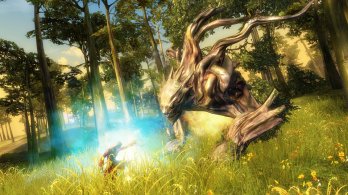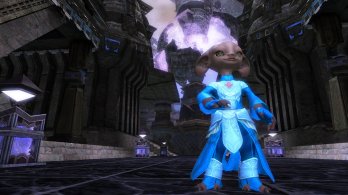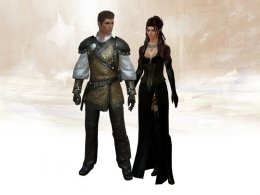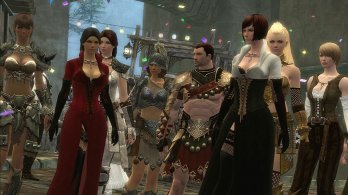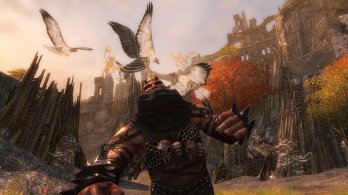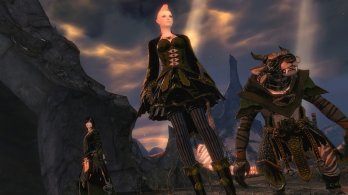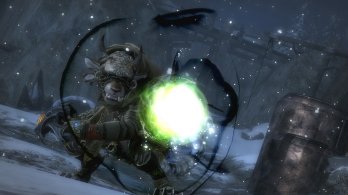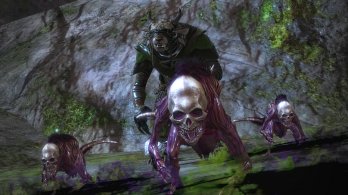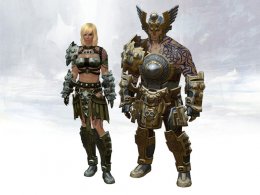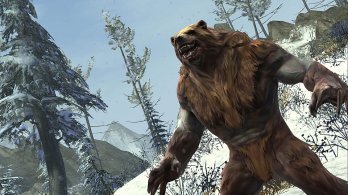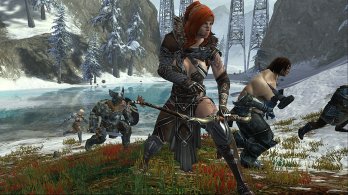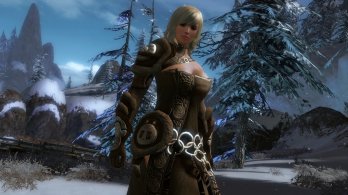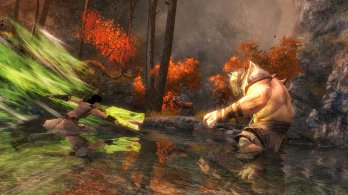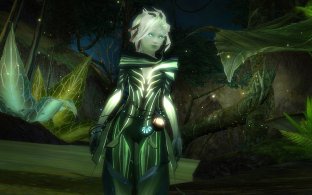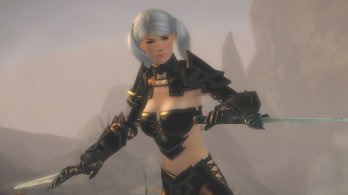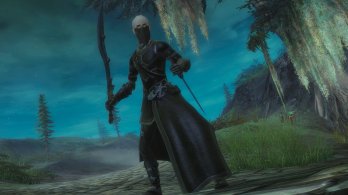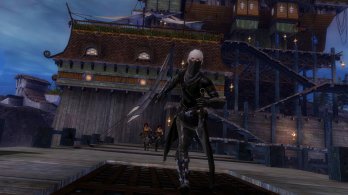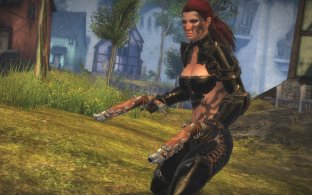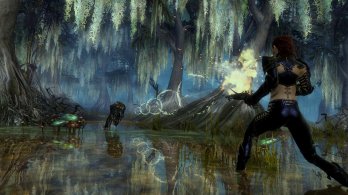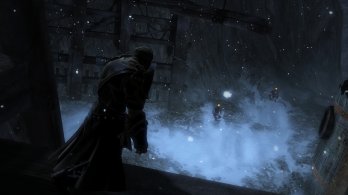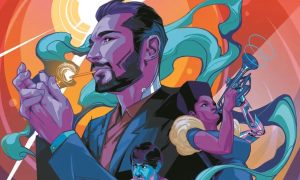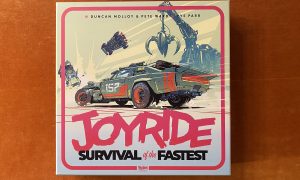 Over this last weekend I got the chance to pop into Seattle-based ArenaNet to get some unrestricted hands-on time with their upcoming title, Guild Wars 2. Before we got started with the event we got to sit down with a brief chat with Mike O’Brian, executive producer of Guild Wars 2. You could tell he was very excited about what his team had to show, but first he wanted to talk about go over some quick items about the first title and how it relates to this one.
Over this last weekend I got the chance to pop into Seattle-based ArenaNet to get some unrestricted hands-on time with their upcoming title, Guild Wars 2. Before we got started with the event we got to sit down with a brief chat with Mike O’Brian, executive producer of Guild Wars 2. You could tell he was very excited about what his team had to show, but first he wanted to talk about go over some quick items about the first title and how it relates to this one.
ArenaNet started in the year 2000 with a very simple premise – they wanted to offer players new and exciting experiences. They wanted to give players the ability to combine the best parts of RPGs without the strict power progression seen in most games. They wanted to make a game that was as much about customizing your own character with unique abilities as it was about having a completely different experience each time you played it. With a skill system that was more like Magic the Gathering rather than the traditional D&D-based model, Guild Wars provided this experience. 7 million players agreed with ArenaNet’s approach, and they ate up the subsequent 4 expansion packs as they were released.
In 2007, ArenaNet did something completely foreign to the standard approach. They announced that Guild Wars 2 was coming in a few years, and that they would be going dark until then. Very few things were released after the 2007 announcement, until just recently. The team went back to the drawing board, not content with what they had achieved with the first Guild Wars title. They asked themselves, first and foremost, what is it that people want out of an online world? What is it that will make players want to inhabit this world for years to come? The answer was simple – they need a game that features a great community that offers players the chance to experience something unique and exciting, but in a world that is evolving courtesy of support from the developer. It seems simple enough on the surface, but what does that mean? The answer was a bit more complex.
Building the Next Generation of MMO
The folks at ArenaNet started development in Guild Wars 2 with a simple question – “What do we all want in a world?” The answer to that question is as complex and unique as the players that play the game, and it is different for every player, so what is next? Well, the approach has to then be about the world. They would focus on the world itself – the very underpinnings of what would eventually support gameplay. They looked at other RPGs and MMOs and found a common issue – nothing you do in most worlds really matters. You collect 5 foozle skins or 8 wizrobe teeth, but in the end, are you really doing anything? Have you really stopped the foozle / wizrobe threat by collecting pelts and chompers? Everyone experiences the same thing, but none of it matters. The 270 gamers that run ArenaNet just blew that concept away – they don’t want to make static worlds.
 The first pillar of Guild Wars 2 is that it is a living world, and you need to be able to impact it. This means that the first thing to go is the traditional quest system. In most games, people run up to the player and proceed to overshare until you click “ok”. In Guild Wars 2, quests are now provided via events. We’ll use the popular “centaur attacks the town” model to illustrate how it works. In one of the first challenges in the human area, there is a town under attack. If you don’t do anything about it, you may lose crucial NPCs (armor seller, repair vendor, etc.), and the centaurs may eventually burn the town to the ground. If you and your friends repel the attack you can push them back and make them retreat. If you continue to push you can then force them across the nearby bridge. Want to really punish them for their hubris? You can further advance, pushing them all the way to their home encampment. By thinning their numbers, you may eradicate or at least suppress the centaur threat for the world for some time. On the other hand, if you don’t push them back that far, they may rebuild over time, get bold, and attack again. This town lives or dies based on your actions – in fact, the entire world will live or die by your action or inaction.
The first pillar of Guild Wars 2 is that it is a living world, and you need to be able to impact it. This means that the first thing to go is the traditional quest system. In most games, people run up to the player and proceed to overshare until you click “ok”. In Guild Wars 2, quests are now provided via events. We’ll use the popular “centaur attacks the town” model to illustrate how it works. In one of the first challenges in the human area, there is a town under attack. If you don’t do anything about it, you may lose crucial NPCs (armor seller, repair vendor, etc.), and the centaurs may eventually burn the town to the ground. If you and your friends repel the attack you can push them back and make them retreat. If you continue to push you can then force them across the nearby bridge. Want to really punish them for their hubris? You can further advance, pushing them all the way to their home encampment. By thinning their numbers, you may eradicate or at least suppress the centaur threat for the world for some time. On the other hand, if you don’t push them back that far, they may rebuild over time, get bold, and attack again. This town lives or dies based on your actions – in fact, the entire world will live or die by your action or inaction.
The second question they had to solve was why any player would go to an online world where they are disconnected from their friends courtesy of a restrictive quest system? If we are playing at the same time, and I’m on a different quest line than you are, I have to run off and kill my 10 critters to finish up my quest, and you have to wait. Maybe we can play again later? ArenaNet wanted to fix this, and the quest system is once again the key. Put simply, the game should be better when there are more players – paradoxically enough, they thought MMOs should be social. As we all had a laugh at that statement, they explained how they think they’ve achieved this objective.
As a personal aside, when I play MMOs I keep my Kindle Fire nearby. I do this as I spend about twice as much time reading as I do playing while I wait for my party to assemble. It’s frustrating beyond belief, but even if you do manage to assemble the party, there is as good a chance that you’ll have trouble competing with other players for mobs. I’m very happy to report that this issue is 100% fixed in Guild Wars 2.
Similar to a system we’ve seen in The Lord of the Rings Online, Guild Wars 2 allows players to join any quest in progress ad hoc. This means that you can jump in at any point, and as long as you do enough damage to qualify as a valid participant (this reduces “twinking” of characters), you’ll get full XP, and full loot for your work. It isn’t ‘locked’ to the person attacking, and it isn’t locked to a party, but don’t think that mobbing is going to get it done – there is a twist. The world of Guild Wars 2 scales dynamically. This means that if you are playing in an event that has you attacking a garrison and more people join the assault, the game will react by having more enemies join the fray. They may also switch up their attacks to utilize more AoE attacks, or otherwise use skills that are more suited to combat more players. This extends to single monsters as they may have more hit points or use more agile tactics as their threat grows. There are boss monsters in the world that do not scale, but these creatures require a good number of characters to take down anyway. While all of this sounds like ArenaNet is discouraging parties, this isn’t the case. If you are in a party you’ll get a separate chat channel and you can mark the compass with waypoints. Beyond that, in short, anyone who is near you is technically in your impromptu party.
The final pillar that ArenaNet wanted to focus on was storytelling. The first Guild Wars title was broken into instanced missions, but Guild Wars 2 is a fully persistent online world. ArenaNet asked once “What is it that single player RPGs have that MMOs don’t?” The answer is simple – single player games have personal stories. They have choices that matter in the world, and the player feels impact when they make those choices. To tackle this, ArenaNet has the players making choices beyond race and class – you’ll fill out a biography as well. Was your character born in the streets, or are they from a noble house? Was your greatest regret that you never joined the circus, or that you never recovered the body of your dead sister? These choices impact the opening cinematic – there are 15 permutations in all, but they also lead to new choices every 10 levels. The level cap is 80, so you’ll be making at least 8 sets of major career and life choices with your character. Below is the character creation story for several of the race and class combinations I got to experience.
Lore, Continuity, and Content – the Pillars of Guild Wars 2
Next up in the presentation group is game lore coordinator, Jeff Grub. You’ll forgive me if my spelling is off, but let me assure you that Jeff is excited about what he does. The game is set in the same world as the original Guild Wars, but it is 250 years in Tyria’s future. While the world was human-centric in Guild Wars, Guild Wars 2 now has 5 races as inhabitants – the Humans, Charr, Norn, Asura, and the Silvari. Following the events of the Eye of the North expansion, the events of Guild Wars 2 was foreshadowed by your battle with The Great Destroyer. You find that he is just the harbinger for the Elder Dragons – vicious forces of nature that exist to dominate and corrupt the world. Primordus, Jormag, Kralkatorrik, and Zhaitan are described as ‘forces of nature’. Fire, Earth, Air, and the power of the undead are at their disposal, and the only way they will be defeated is if the races can come together and dedicate themselves to their destruction. Your character starts as a simple local hero, known to the people, but not quite a force to be reckoned with. It will take some time to discover the truth of the greater dangers in the world, aligning the races into three orders, and eventually one unified force.
 Next to take the stage in our presentation was Lead Content Designer, Colin Johansen. His focus was about describing in greater detail the three pillars behind the design of Guild Wars 2. Going back to the first pillar, your personal story, there are far more permutations beyond the simple decisions. For instance, if you play as the Charr, does your character come from the Iron, Ash, or Blood Legion? If you are from the Blood Legion your character will inhabit the front line of battle, and you end up as the head of a warband. You must overthrow this warband and work your way up through the legion as you work your way through your first 10 levels. When you do overthrow that warband leader, you’ll have the option to let him live or to end his life, which has obvious later implications to your honor or that character possibly reappearing later. If you select the Ash Legion you’ll act as a spy or a necromancer trying to infiltrate the Flame Legion. Your objective then is to locate this group and eliminate their spy leader. The Iron Legion are the engineers for the warband, building siege engines to be used on the front line. As I mentioned earlier, every 10 levels you’ll be hit with another set of questions such as whether your father was a sorcerer, an honorable warrior, a coward, or other options. You may even pick things like who your best friend was, giving you a chance to build them up and eventually determine their fate as well. Each race has their own unique storylines similar to these examples, and Colin promised that by the time we hit level 80 we’ll have worked through thousands of possible permutations. In fact, if you are inclined you can click on the Hero Journal and read through those permutations in a storybook format called the Hero Journal. Who your character was, is, and is striving to become is all spelled out here – you are no longer a nameless and faceless warrior.
Next to take the stage in our presentation was Lead Content Designer, Colin Johansen. His focus was about describing in greater detail the three pillars behind the design of Guild Wars 2. Going back to the first pillar, your personal story, there are far more permutations beyond the simple decisions. For instance, if you play as the Charr, does your character come from the Iron, Ash, or Blood Legion? If you are from the Blood Legion your character will inhabit the front line of battle, and you end up as the head of a warband. You must overthrow this warband and work your way up through the legion as you work your way through your first 10 levels. When you do overthrow that warband leader, you’ll have the option to let him live or to end his life, which has obvious later implications to your honor or that character possibly reappearing later. If you select the Ash Legion you’ll act as a spy or a necromancer trying to infiltrate the Flame Legion. Your objective then is to locate this group and eliminate their spy leader. The Iron Legion are the engineers for the warband, building siege engines to be used on the front line. As I mentioned earlier, every 10 levels you’ll be hit with another set of questions such as whether your father was a sorcerer, an honorable warrior, a coward, or other options. You may even pick things like who your best friend was, giving you a chance to build them up and eventually determine their fate as well. Each race has their own unique storylines similar to these examples, and Colin promised that by the time we hit level 80 we’ll have worked through thousands of possible permutations. In fact, if you are inclined you can click on the Hero Journal and read through those permutations in a storybook format called the Hero Journal. Who your character was, is, and is striving to become is all spelled out here – you are no longer a nameless and faceless warrior.
The second pillar presented is Dynamic Events. The example presented came from the human area and describes some bandit infestation of a local pump house that brings water to the nearby local farms. The bandits are trying to destroy the water supply in various ways starting with blowing up the pipeline. If players can stop the bombers, you can save the nearby farms which keep the merchants and farmers gainfully employed. If you fail you’ll have to then escort workers to try to repair the pipes. As there is no water, the farms will begin to rot, letting new critters spawn. The lack of income means that local merchants can’t sell their goods. Stopping the bandits gives them pause, but they’ll regroup and then attempt to poison the water instead. If you can’t stop this assault, they’ll poison the water supply, covering the nearby farms with toxins. These toxins will allow “Poison Grubs” to spawn, and the nearby townspeople will begin to get sick. Eventually the townspeople will begin to die, pleading to you for help. The great thing is that you can encounter this event at any point in the story. This means you may join this quest after the bandits have already succeeded in poisoning the water, or you might join it before they take any action at all. All of the quests in the game are set up in this fashion, so every time you play it should be different.
The final pillar is the combat engine. To that end, the first change they made was to get rid of the Holy Trinity of DPS, Tank, and Healer. Instead, they went for a fluid combat system. This means that everyone has a dedicated healing skill, crowd control skills, and combat skills. Non-caster classes can switch weapons on the fly and change the role that character plays. You can flip from double-axes to ranged and be no weaker for the change. This means you can react to combat instead of being locked into a particular role. It means that all the professions can shift roles and fight together rather than, as an example, sitting in the back and healing or throwing DPS. The hitch is that the enemies are similarly designed, allowing them to change tactics as well, so you’ll have to learn to adapt.
The final presenter before we got our hands on the game was Daniel Dociu, the Lead Director of Art Style for Guild Wars 2. His team presented a vision for the game – to strike the balance between accessibility and style. He cited a specific truth that long-time gamers would understand; the more generic you make the game the less you upset your audience, but it makes it harder to stand out. On the other side of that coin, the more you push the level of abstraction, the more polarizing it gets. They would need to strike a balance between those two opposites to make Guild Wars 2 stand out and succeed. He believes (and I agree) that the artistic treatment shouldn’t be a side product or a layer on top just to make things pretty – it should be an integral part of the game. With Guild Wars 2, Dociu and his team worked hard to give the game a handcrafted look, ensuring that no part feels generic. Everything should feel like it was created for a purpose, and for you specifically. I like the art direction of the game, but I will leave it up to you to determine if it resonates with you.
Gameplay – We Enter The World of Guild Wars 2
To kick off our hands-on time, we were given the chance to fire up a brand new Human character. At this point in the Guild Wars mythos/timeline, humans have lost their homeland, their security, their former glory, and their global dominance. Their gods have withdrawn, but somehow the human spirit remains unshaken. They may have been beaten back, but they are not defeated; mankind holds its ground at Divinity’s Reach – a massive city, large enough to comfortably house hundreds of players. Before we move into gameplay, let me show you the introduction for the Charr, Norn, and Human races, and just one of 15 possible starting stories…
Divinity’s Reach acts as a central hub for players, offering crafting skills including leather working, Artificing, Cooking, Tailoring, and many more . As you traverse the city you are informed of how many points of interest, waypoints, skill challenges, and tasks are available in the area, and you’ll earn valuable experience by simply exploring your environment.
Opting to continue my storyline, I entered an instanced area. If I were partied up with friends, they could come along for the trip, but I was running this section solo. Before I stepped into the instance I was warned that I was not an appropriate level for the quest – I ignored the warning and pressed on. Fully-voiced conversations in these instances take place in a side-by-side window that you can skip if you are inclined, but the developers cautioned that if they are taking the time to drag you away from the action, there is something to be learned here. As I was noble-born, some friends had gathered outside my home to celebrate my return, but the party was quickly broken up when some bandits stormed in. Taking my good friend Faren hostage, the bandits flee the scene with us in tow. Fighting our way into a nearby house, we ascend the stairs and take on our first sub-boss – the bandit leader. It was during this fight that I found out about the new death mechanic.
When your character suffers enough wounds you’ll be dropped to the ground and presented with four options to try to save yourself. This last ditch effort offers you options based on your character class. You might sling lightning bolts, rocks, or consume your minions for health based on your selected profession. Any player, party member or no, can resurrect you, or if you are lucky you could Rally back to your feet by striking down a nearby weakened foe. If your enemy is otherwise distracted, you could also use a bandage to slowly recover health over time. If you expire completely the game will fade to gray and offer you the chance to teleport back to a nearby starting point, sporting some damage to your  armor and a penalty to health. Surprisingly, even if you are completely out of the battle, it is still possible to resurrect you! This means that even if a player couldn’t reach you in time to save you, all is not lost. As you watch our video series, you’ll see a few instances where I suffered this fate.
armor and a penalty to health. Surprisingly, even if you are completely out of the battle, it is still possible to resurrect you! This means that even if a player couldn’t reach you in time to save you, all is not lost. As you watch our video series, you’ll see a few instances where I suffered this fate.
With my friend Faren eventually rescued, I set out for adventure in the world proper. It was here that I encountered the much-touted quest system. As I checked out the local vendor market, a villager ran up and began shouting how the bandits were attacking the water supply to anyone who would listen. It wasn’t an interrupt, and it wasn’t even necessarily directed at me, but I now had a quest just the same…or at least I would when I got around to it. Since I chose to ignore the quest, eventually I noticed a toxic green gas begin to flow across the nearby field, and NPCs began to get sick. Before I could set off across the map to deal with the situation, suddenly the sprinklers began spraying clean water once again and soon the townspeople were back to their normal selves – another set of players had just stopped the bandit threat and affected the world around me.
As the world around me changed, it suddenly occurred to me how a crowded world could leave me with very little to do. I talked to a developer about population caps and was introduced to a queue alternative called “Overflow worlds”. When your selected server is too busy, rather than being given a queue and not being allowed to play, you’ll be placed on a temp world. This world will keep track of all that you do, and all of that credit, loot, xp, and the like will be transferred to your chosen world immediately when a slot opens up. It is an elegant solution to an age-old problem. It also ensures that there are not so many people online in an area that you are left with nothing left to do because a marauding set of players have simply solved all the area problems. While these caps and balancing will be decided as more players are introduced into the environment, it is nice to know that ArenaNet has already thought of this issue and is prepared to deal with it.
Taking my Elementalist Pyrrah into the field, I encountered a completely new take on the magic using profession. While every MMO has you gain new skills on level up, Guild Wars 2 has you earn new skills on use. My Elementalist had just one fire spell to start, but as I used that spell and became more familiar with it, it unlocked a second. Eventually it unlocked a third, a fourth, and a fifth skill before finally unlocking another element. By the time I hit level 10 I had unlocked 4 elements with 5 skills each. Unlike many games, the different elements are not a direct parallel to one another. My fire skills were heavy on concussion and damage over time, where my water skills were used more for healing and dispelling. Lightning stunned and handled crowd control, while Earth crushed my enemies with huge boulders. All of them had area of effect spells, and none of them felt wasted – a difficult feat for 20 total skills. This tied once again into the pillar that ArenaNet is aiming for – flexibility in the character instead of just in the class.
The skills, regardless of class, are broken into two halves of your hotbar. To further focus players, there is only one hotbar and it never expands. The left 5 keys are your attacks (attacks for warriors, spells for casters, as an example) and the skills on the right are skills you choose from your unlocked skills. This means that the left side of your bar may change wildly depending on the particular weapon you have selected. A warrior using a musket will have a certain set of skills, but hitting the weapon swap button will change all five of those buttons when you move to double axes. You’ll see a lot of this as you look through the PVP videos we’ve provided for you. With so many skills and so many combinations, there is no such thing as a ‘perfect class’ anymore. As you and four of your friends crash the dungeons that start at level 30, the class you bring, whatever it is, is perfect for this dungeon – Guild Wars is about rewarding players who play the game well, not just players who can play a strictly-defined class.
Before I ended my visit to the studio, I got to see some minor elements of the tailoring system. Players will gather materials in the usual way, skinning critters, getting drops, deconstructing gear you don’t need, and mining, as examples, but you don’t buy your recipes as your level goes up – you’ll experiment to attain that next item. This is done with a discovery tab that allows you to drag up to four components together and create something with them. It may be a new sleeve that could be later combined with a leather jerkin to create a piece of armor, or it could be aggregating some pieces of leather and string to create leather panels to be used more generally. Further supporting their cooperative aims of Guild Wars 2, it’s important to note that farmable items (e.g. iron nodes, wood, etc.) are not single-use. If two people race towards that consumable, it doesn’t disappear when the first person uses it – both players can farm it and both get full credit. The developers noted that loot is staggered at every other level for usability – player crafted Level 5 items trump the level 4 loot drops, and then level 6 loot drops trump the level 5 crafted items. It ensures that there is always a market available for players to drive the economy.
All told, I got to play through about 10 hours of time with Guild Wars 2, and I came away impressed. The game is a fresh look on the MMO landscape, and the way it has broken the standard conventions is clearly working. Playing with other players has always been a chore, but with Guild Wars 2, more players meant more fun. The leveling curve has been flattened (from level 1 to 2 is about 45 minutes, and from level 79 to 80 is also about 45 minutes), and a heavily player-focused crafting economy is promised at launch. We’ll cover PVP and dungeons in another preview, but I have to say that as a PvE MMO, Guild Wars 2 is one you should be excited to try for yourself. If you haven’t already done so, sign up for the upcoming beta weekend – I’ll see you online. In the mean time, enjoy 102 screenshots you may or may not have seen. Stay tuned as we launch our extensive PVP coverage, a run through the first dungeon, and World vs. World gameplay shortly!
– Ron Burke
Director of Gaming Trend
Editor in Chief
Ron Burke is the Editor in Chief for Gaming Trend. Currently living in Fort Worth, Texas, Ron is an old-school gamer who enjoys CRPGs, action/adventure, platformers, music games, and has recently gotten into tabletop gaming.
Ron is also a fourth degree black belt, with a Master's rank in Matsumura Seito Shōrin-ryū, Moo Duk Kwan Tang Soo Do, Universal Tang Soo Do Alliance, and International Tang Soo Do Federation. He also holds ranks in several other styles in his search to be a well-rounded fighter.
Ron has been married to Gaming Trend Editor, Laura Burke, for 28 years. They have three dogs - Pazuzu (Irish Terrier), Atë, and Calliope (both Australian Kelpie/Pit Bull mixes), and an Axolotl named Dagon!

See below for our list of partners and affiliates:
